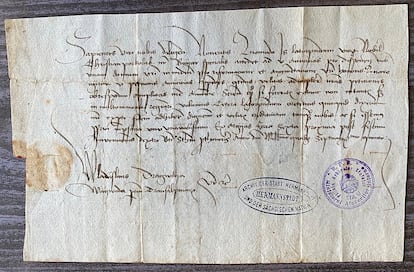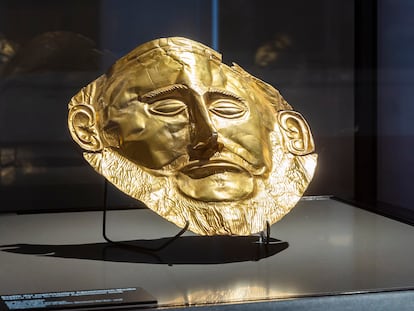What was the real Dracula like? Four ‘chemical historians’ look for the answer in proteins
Two Israeli biotech entrepreneurs and two Italian chemists analyzed three 15th-century letters signed by the Wallachian prince Vlad the Impaler, who inspired Bram Stoker’s vampire tale

In his 1897 novel about history’s most famous vampire, Bram Stoker mentions blood and the color red more than 200 times, often when talking about Dracula’s eyes. “The last I saw of Count Dracula was his kissing his hand to me, with a red light of triumph in his eyes, and with a smile that Judas in hell might be proud of,” says one of the book’s protagonists, Jonathan Harker on being left alone in the Carpathian castle with the “brides,” three vampires who foresaw “kisses for all” because Harker was “young and strong.”
Did Vlad Dracula, the cruel 15th-century European prince who inspired the book, have hemolacria, or was it just a literary device by Stoker to allude to sexual desire during the conservative Victorian era, which meant that the most iconic screen Dracula, Christopher Lee, had to wear red contact lenses during his scenes, something he hated? Two Israeli biotech entrepreneurs and two Italian chemists are currently looking for the answer in the proteins that Vlad Dracula left hundreds of years ago when he signed three letters.
The word Dragulya can be seen in the red wax seal and in the signature of one of the documents, filed in the Romanian National Archive. Dragulya was one of the pseudonyms used by Vlad III, also known as The Impaler because of his fondness for killing Transylvanian Saxons and Ottomans in this manner. Born in Transylvania in 1431, he ruled with an iron fist in Wallachia, a former principality within present-day Romania.

In one of the letters, dated 1475, shortly before his death on the battlefield, Prince Vlad introduced himself as “Prince of the Transalpine regions” to the burghers of the Transylvanian city of Sibiu where he would settle. Stories were already circulating about his brutality in neighboring Wallachia, including one describing how terrified Ottomans discovered a forest of impalements. In Romania, the Prince is considered a national hero who defended his land in an era when few rulers governed with any contemplation.
Three years ago, the Israelis Gleb, 53, and Svetlana Zilberstein, 53, teamed up with the Italians Pier Giorgio Righetti, 81, and Vincenzo Cunsolo, 60, to obtain permission to analyze the documents from the archives using a method that collects the proteins still present due to contact with any part of the body, such as sweat, saliva or tears. Under the right conditions, these proteins can remain on the documents for up to millions of years. “It doesn’t require tearing off a piece of the document and proteins are more stable than DNA, which deteriorates more over time,” explains Gleb Zilberstein at a café in Tel Aviv, Israel, where he and his wife Svetlana emigrated 26 years ago from their native Kazakhstan. Gleb has a master’s degree in physics and Svetlana in economics. But they are not traditional academics, nor do they have university teaching posts. Rather, as Gleb says, they are “typical Israeli high-tech entrepreneurs.” Righetti,on the other hand, is Emeritus Professor of Chemistry at the Polytechnic University of Milan, while Cunsolo teaches organic chemistry at the University of Catania.

Their method involves ionized plastics that are deposited on the object. These absorb proteins, other biomolecules and metals capable of shedding light on disease, medication, food and even the environment in which Dracula lived. “We work in two directions,” says Gleb. “On the one hand, biomarkers generated in the organism of a human being. On the other, proteins from microbes.”
This is what they like to call chemical history. “We are not detectives, although the method can be used in forensic analysis,” says Svetlana. The process makes it possible to determine whether a protein came from a human, a rat or a mosquito that landed on the document. It can also put a date on when that happened. There is, however, an element of assumption when all the other evidence indicates a certain conclusion to be justified. “It helps that the paper was made from cotton fibers at the time and is very well preserved,” Svetlana says. In fact, these documents have rarely been touched since the 15th century, according to the preliminary results of the tests.
Disease dictates behavior
The Zilbersteins are not yet ready to reveal their conclusions about Vlad III. They won’t do so until these are confirmed in Italy, although they did reveal that two of the 10 human proteins attributed to Vlad indicate illness – a hardening of the arteries, which can obstruct the veins of the retina or conjunctivitis so acute that it may have produced blood in the tears. “When we have information about specific diseases, we can provide material for historians to speculate on,” says Gleb. “Disease dictates behavior.” They did not go into the cause of death because it is already known (fighting Ottoman forces) and the body was never found.
These chemical historians usually focus on famous historical or literary figures. And they do their research before the biological analysis to know what clues to look for and to be able to connect history and chemistry. This time they chose Dracula as “he is an ideal character for understanding the political games of the time,” says Gleb. “We wanted to understand who he was: an actual dictator or a victim of the political-military situation.” He adds that it is also interesting from a medical point of view due to the many stories concerning his health, but also from the point of view of exploring the climatic conditions and the bacterial universe prior to Christopher Columbus’ arrival in America.

The first joint mission undertaken by the four scientists was the original manuscript of a key 20th-century novel: The Master and Margarita, to which author Mikhail Bulgakov devoted the last years of his life. The analysis revealed biological indicators that the writer, who had practiced as a physician, took a lot of morphine and painkillers for a kidney disorder called nephrotic syndrome.
“We generate data to destroy paradigms,” says Gleb. “We lay out the findings and open a debate.” For example, historians were already in agreement that 1984 author George Orwell died of tuberculosis in 1950. But after analyzing a letter he sent to Moscow, it was also concluded that he had contracted the disease in the hospital where he was recovering after being shot fighting for the Republicans during the Spanish Civil War. The Russian writer Anton Chekhov also had tuberculosis, but they believe he died of a stroke, because of a protein they found in one of the analyses.
Sign up for our weekly newsletter to get more English-language news coverage from EL PAÍS USA Edition
Tu suscripción se está usando en otro dispositivo
¿Quieres añadir otro usuario a tu suscripción?
Si continúas leyendo en este dispositivo, no se podrá leer en el otro.
FlechaTu suscripción se está usando en otro dispositivo y solo puedes acceder a EL PAÍS desde un dispositivo a la vez.
Si quieres compartir tu cuenta, cambia tu suscripción a la modalidad Premium, así podrás añadir otro usuario. Cada uno accederá con su propia cuenta de email, lo que os permitirá personalizar vuestra experiencia en EL PAÍS.
¿Tienes una suscripción de empresa? Accede aquí para contratar más cuentas.
En el caso de no saber quién está usando tu cuenta, te recomendamos cambiar tu contraseña aquí.
Si decides continuar compartiendo tu cuenta, este mensaje se mostrará en tu dispositivo y en el de la otra persona que está usando tu cuenta de forma indefinida, afectando a tu experiencia de lectura. Puedes consultar aquí los términos y condiciones de la suscripción digital.
More information
Últimas noticias
There is as much life left to discover on planet Earth as that which is already known
Dozens presumed dead, around 100 injured in fire at Swiss Alps bar during New Year’s celebration
Is porn for women different from conventional porn? We spoke to those who make it
Cartagena de Indias is sinking: What can the city do to mitigate it?
Most viewed
- David King, chemist: ‘There are scientists studying how to cool the planet; nobody should stop these experiments from happening’
- Reinhard Genzel, Nobel laureate in physics: ‘One-minute videos will never give you the truth’
- Oona Chaplin: ‘I told James Cameron that I was living in a treehouse and starting a permaculture project with a friend’
- Sinaloa Cartel war is taking its toll on Los Chapitos
- The Interoceanic Train, the Mexican alternative to the Panama Canal











































